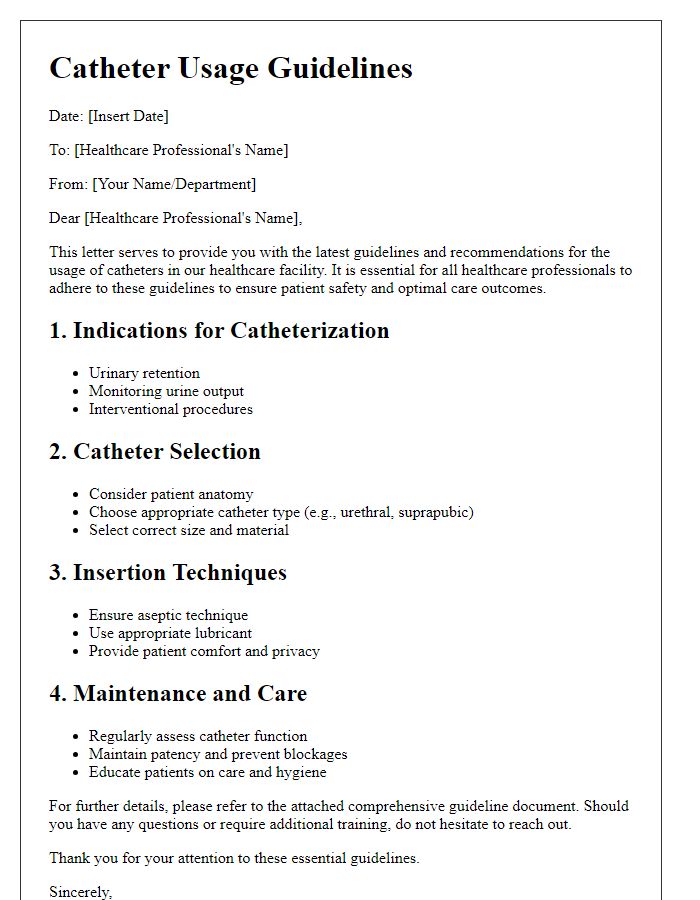Are you looking for a comprehensive guide on catheter care? Proper catheter management is crucial for maintaining comfort and preventing infections, whether you're a caregiver or a patient. In this article, we'll explore essential tips and techniques to ensure the best care for catheters, making your experience smoother and safer. So, let's dive in and discover effective practices that can make all the differenceâread on!

Patient Identification and Information
Proper catheter care is essential for preventing infections or complications related to urinary catheters, such as Foley catheters commonly used in hospitals. Daily cleaning of the catheter insertion site with soap and water significantly reduces the risk of catheter-associated urinary tract infections (CAUTI). Keeping the drainage bag below bladder level prevents backflow and maintains urine flow, while ensuring that the bag is emptied regularly (typically every 4-6 hours) can prevent overfilling. Patients should be instructed to maintain a secure catheter position, avoiding any pulling or tugging that may irritate the urethra. Monitoring for signs of infection, such as fever, chills, or changes in urine color, will help detect complications early. Regular follow-ups every few weeks will facilitate timely adjustments and replacements, ensuring optimal catheter functionality and patient comfort.
Step-by-Step Catheter Handling Instructions
Proper catheter care is essential to maintain hygiene and prevent infections associated with urinary catheters, which are medical devices inserted into the bladder for urine drainage. Begin by washing hands thoroughly with soap and water for at least 20 seconds, ensuring to clean under nails and between fingers. Prepare a clean workspace, using disposable gloves to minimize contamination. For catheter cleaning, utilize sterile saline or antiseptic wipes, focusing on the insertion site and the first few inches of the catheter tubing. Secure the drainage bag below bladder level, avoiding kinks in the tubing to promote free flow of urine. Empty the drainage bag when it reaches three-quarters full to prevent backflow, and always record the volume of urine collected. Change the catheter according to the healthcare provider's schedule, typically ranging from every 2 to 12 weeks depending on type and individual circumstances. Monitor the catheter site daily for any signs of infection, such as redness, swelling, or discharge, and report any concerns to a healthcare professional promptly.
Hygiene and Infection Prevention Guidelines
Maintaining proper hygiene and infection prevention measures is essential for catheter care, particularly for indwelling urinary catheters. Clean hands (using soap and water or alcohol-based sanitizer) prior to any manipulation of the catheter or drainage system is critical to minimize the risk of introducing pathogens. Regular cleaning of the catheter site with antiseptic solutions (such as chlorhexidine) should occur at least once daily. The drainage bag must remain below bladder level at all times to prevent backflow, which can lead to urinary tract infections. Additionally, changing the catheter and drainage bag according to facility protocols (generally every 4 to 6 weeks for catheters) is crucial for reducing infection risk. Regular monitoring for signs of infection (such as redness, swelling, or discharge at the insertion site) should be conducted, prompting immediate medical evaluation if any symptoms arise. Proper disposal of used catheters and related materials must adhere to local biohazard waste regulations to ensure environmental safety.
Troubleshooting Common Issues
Catheter care instructions are crucial for maintaining hygiene and preventing complications. Common issues may include blockage, leakage, or infection. Blockage is often caused by sediment buildup or kinking in the tubing, requiring regular flushing with sterile saline. Leakage can result from improper securement or malposition, necessitating adjustment or replacement of the catheter, especially in urinary catheters, often used in hospitals like Johns Hopkins Hospital. Infections, with symptoms such as fever over 38 degrees Celsius and redness, necessitate immediate medical attention. Proper hand hygiene before handling the catheter, regular inspection, and maintaining the drainage bag below bladder level are essential practices for effective catheter management.
Contact Information for Medical Assistance
Proper catheter care is essential to prevent infections and complications associated with urinary catheters, such as silicone or latex. Regular cleaning of the catheter insertion site should occur at least once a day, using mild soap and water to minimize irritation. Ensure to check for any signs of infection, including redness or discharge around the insertion site. Additionally, maintain a secure catheter strap to prevent unnecessary movement, which could lead to discomfort or injury. Patients should also empty their drainage bag, generally a urinary leg bag or a bedside collection bag, at least every 4 to 6 hours to reduce the risk of backflow and maintain optimal urine drainage. For any concerns, including fever or changes in urine color, contact your healthcare provider immediately, preferably a urology specialist familiar with catheter management. Always have numbers for medical assistance readily available, ensuring prompt action if complications arise.
Letter Template For Catheter Care Instructions Samples
Letter template of catheter usage guidelines for healthcare professionals.













Comments